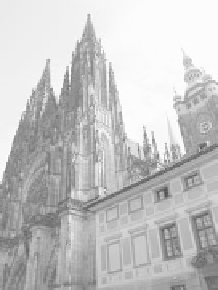Travel Reference
In-Depth Information
Cathedral l Facade:
Before entering, check out the facade.
What's up with the guys in suits carved into the facade below
the big round window? They're the
architects and builders who finished
the church. Started in 1344, construc-
tion was stalled by wars and plagues.
But, fueled by the 19th-century rise
of Czech nationalism, Prague's top
church was finished in 1929 for the
1,000th anniversary of the death of St.
Wenceslas. While it looks all Gothic,
it's actually two distinct halves: the
original 14th-century Gothic around
the high altar, and the modern Neo-
Gothic nave. For 400 years, a tempo-
rary wall sealed off the functional, yet unfinished, cathedral.
Mucha Stained-Glass Window:
Enter through the gate
on the left with the fenced-off queuing area, and find the third
window on the left. This masterful 1931 Art Nouveau window
is by Czech artist Alfons Mucha (if you like this, you'll love
the Mucha Museum in the New Town—see page 82; also see
Mucha's masterpiece,
Slav Epic,
described on page 222).
Notice Mucha's stirring nationalism: Methodius and Cyril,
widely considered the fathers of Slavic-style Christianity, are top
and center. Cyril—the monk in
black holding the Bible—brought
the word of God to the Slavs.
They had no written language
in the ninth century—so he
designed the necessary alphabet
(Glagolitic, which later devel-
oped into Cyrillic). Methodius,
the bishop, is shown baptizing a
mythic, lanky, long-haired Czech
man—a reminder of how he brought Christianity to the Czech
people. Scenes from the life of Cyril on the left and scenes from the
life of Methodius on the right bookend the stirring and epic Slavic
scene. In the center are a kneeling boy and a prophesying elder—
that's young St. Wenceslas and his grandmother, St. Ludmila. In
addition to being specific historical figures, these characters are
also symbolic: The old woman, with closed eyes, stands for the past
and memory, while the young boy, with a penetrating stare, repre-
sents the hope and future of a nation. Notice how master designer
Mucha draws your attention to these two figures through the use
of colors—the dark blue on the outside gradually turns into green,
then yellow, and finally the gold of the woman and the crimson of




















